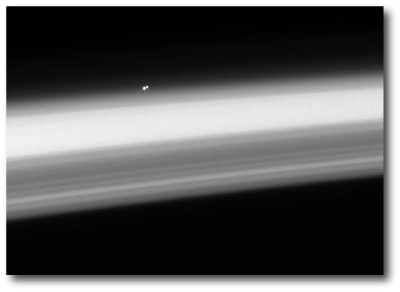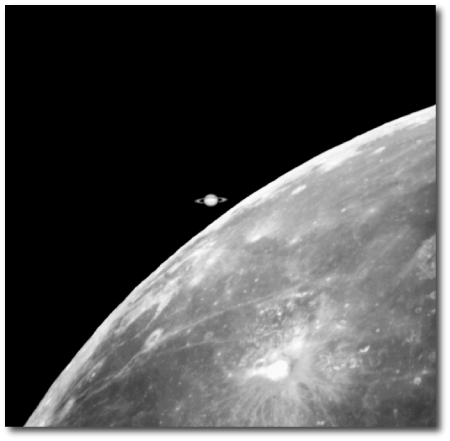
Image Source.
Last May, Mark Marley sent me a link to the photograph shown above. It’s a Cassini image of Alpha Centauri A and B hanging just above the limb of Saturn. It provides an interesting bookend to the remarkable pictures that can be taken from Earth when Saturn and the Moon are close together in the sky. Mystery on the scientific horizon of the year 1610 has transformed itself into mystery on the horizons of today.

Image source.
It’s also a nice coincidence that the actual distance between the two components of Alpha Cen is similar to the distance between Earth and Saturn. Right now, Alpha Cen A and B are more than 20 AU apart, but within our lifetimes, they’ll close to nearly the Earth-Saturn distance as they reach the next periastron of their 80-year orbit in May 2035.
We’re fortunate that we’ve arrived on the scene as a technological society right at the moment when a stellar system as interesting as Alpha Cen is in the very near vicinity. During the last interglacial period, Alpha Cen did not rank among the brightest stars in the sky. A hundred thousand years from now, the Alpha Cen stars will no longer be among our very nearest stellar neighbors, and in a million years, they will have long since faded from naked-eye visibility. At the moment, though, Alpha Centauri is drawing nearer at 25 km/sec, a clip similar to the Earth’s orbital velocity around the Sun. It’s as if we’re on the free trial period of an interstellar mission…
And what of the status of the observational search? In the interim since the last oklo.org update, Debra Fischer obtained one year of NSF funding to begin high-cadence radial velocity observations of the Alpha Cen system with the CTIO 1.5m telescope in Chile. Debra, along with Javiera and a number of CTIO scientists have worked very hard to get the telescope and a spectrograph into condition for high-precision Doppler work. Many nights of Alpha Cen observations have now actually been carried out, and by all indications, the prospects look quite promising from an instrumental standpoint. The project will need long-term funding, though, since it will take of order 3-5 years of dedicated observation to reach any truly habitable worlds that are orbiting our nearest stellar neighbors.
